The 29cm baffle is acoustically narrow to the Seas L21 midbass and is well below the 2.2 rule of thumb. I have to take it out for proper measurements later but from experience it would likely be very smooth to 1.6khz, which is usable.
I did only indoor measurements so far to find out the dipole peak, which is 460Hz. Close to Orion (400hz) and is consistent since Orion have slightly wider baffle and is folded.
What's more worrying was the L21 do not have flat response from 300-1kHz region. Hence the dipole SLP started further above to compensate this, which is around 680hz.
One day I will try the no-baffle approach and see. At the moment the physical construction complexity is a bit too much 😀
I did only indoor measurements so far to find out the dipole peak, which is 460Hz. Close to Orion (400hz) and is consistent since Orion have slightly wider baffle and is folded.
What's more worrying was the L21 do not have flat response from 300-1kHz region. Hence the dipole SLP started further above to compensate this, which is around 680hz.
One day I will try the no-baffle approach and see. At the moment the physical construction complexity is a bit too much 😀
Hi gainphile,
Do you really run out of Xmax of the woofers?
Or the system can not take any more EQ boost?
Or, did you still EQ it flat to 20Hz? Oh, no!
Do you really run out of Xmax of the woofers?
Or the system can not take any more EQ boost?
Or, did you still EQ it flat to 20Hz? Oh, no!
I still equalise it down to 20Hz. The depth of the sound is still there, but since I need to equalize more they run out of excursion much quicker. That extra 24cm the H-frame provided really makes a big difference in terms of maximum output.
I listen at "concert level" about once a week only when the wife/kids are away so I'm not missing much.
I listen at "concert level" about once a week only when the wife/kids are away so I'm not missing much.
Those big woofers are calling....
To reproduce Bass from an OB speakers each side needs at least twin 15" woofer to give you the impact ie down to 35-40Hz and sound stage, in a small room/enclosure they look daunting to horrible and the sound reproduction can be overwhelming.
Possibly a good compromise is a twin 12" woofer mounted in W-frame hence reducing the width and the sight is not so daunting. Refer to a commercial speakers by GR research, model: V2 system.
You can always make a vertical 18" ripole bulit under the cabinet with flower on it 🙂
This way it could be a little bit camouflaged...
This way it could be a little bit camouflaged...
Or 18" Ripole subwoofer built under the cabinet with flower on it. If you'd run it up to 80hz maybe 100hz one should be enough.
Thanks. The slopes are 1.5khz and 120hz. All LR4. Some usual SLP and notches for OB.
Yes, Pluto (clone) is a love-hate relationship. They have the best holographic and realistic imaging, yet the sound is coloured by the "box". One immediately notice this when swapping over. I've done numerous swaps before.
So this S12 imaging is close to Pluto, but not there yet. For that I have to use narrower baffle like my "S9". But tonality and "purity" of sound they're miles ahead.
I've done over a thousand loudspeaker measurements in the past year, and the thing that always stands out is that a loudspeakers polar response is dramatically affected by diffraction off the cabinet edge.
It's a bit of a mystery to me why Linkwitz dismisses this effect on his site, since the evidence in a polar plot is as clear as day.
Anyways, if you want to improve the sound, you might consider using a roundover on the edges, instead of a sharp transition from one angle to the other.
The measurements show an improvement, and subjectively, the cabinet seems to "disappear."
I am now more towards lying the bass-baffle down and introduce some angle between units. Here is a simulation with a 50 x 80 cm baffle with 2 Eminence Alpha15s, LP at 200 Hz 12 dB/oct LR:
Combining this with Stig-Erik's way of hanging units, not really in one chain but more flexible so that you can adjust for time alignment between units. With or without baffles.
This I think would be a great way to go. 🙂
/Erling
An externally hosted image should be here but it was not working when we last tested it.
An externally hosted image should be here but it was not working when we last tested it.
Combining this with Stig-Erik's way of hanging units, not really in one chain but more flexible so that you can adjust for time alignment between units. With or without baffles.
This I think would be a great way to go. 🙂
/Erling
Last edited:
Measurements ... at last !
Patrick Bateman's comment interested me. One reason being the diffraction effect must be avoided as much as possible and JohnK in his website argues about the importance of plain baffle, i.e. no wings.
The problem is, while I do like wingless baffle, it does not provide sufficient physical support. The OB would sway and vibrate visibly with organ passages 😎.
So for structural support I added strips of 4cm wing. Let's see now how it measures.

My typical outdoor measurement. Plenty of bush around for "attenuation" and I prefer ungated measurements. It is very difficult with weather and birds! Smallest wind blow and birds chirping shows in the measurements. The neighbour mowing the lawn did not help either 😀
Patrick Bateman's comment interested me. One reason being the diffraction effect must be avoided as much as possible and JohnK in his website argues about the importance of plain baffle, i.e. no wings.
The problem is, while I do like wingless baffle, it does not provide sufficient physical support. The OB would sway and vibrate visibly with organ passages 😎.
So for structural support I added strips of 4cm wing. Let's see now how it measures.

My typical outdoor measurement. Plenty of bush around for "attenuation" and I prefer ungated measurements. It is very difficult with weather and birds! Smallest wind blow and birds chirping shows in the measurements. The neighbour mowing the lawn did not help either 😀
Wing vs no wing
This is the measurement of baffle with no structural wing (my reason for wing is not for bass extension but physical support). It's somewhat similiar to the Phoenix, just a bit narrower.
No structural wing:

With wing:
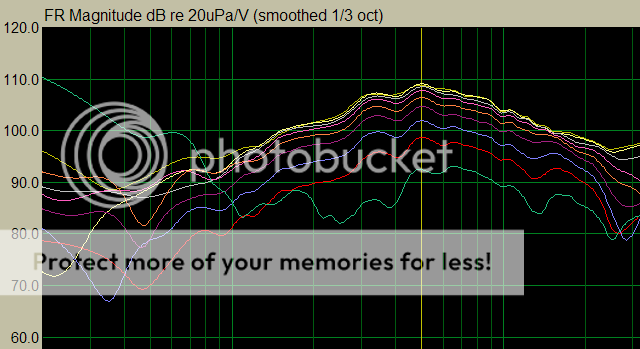
Immediately we can see the typical smooth response of narrow open baffle. 6db drop is also clearly formed as well as the dipole peak. The smoothness ends between 1khz-2khz (first null) where the response widens, shown as bunched up lines.
With no wings, this occurence occurs a bit higher, perhaps 100 or 200hz or so. This is expected because the wings created some extra path length.
More interesting is the difference in directivity. The wings actually made the response wider. The no-wings have more directivity. It is also very important to observe here that both have smooth response up to the first null. Also the wing provided a somewhat smoother response after 1khz.
I think I'm quite happy to find that the difference between having structural wing and no wing is quite negligible.
This is the measurement of baffle with no structural wing (my reason for wing is not for bass extension but physical support). It's somewhat similiar to the Phoenix, just a bit narrower.
No structural wing:

With wing:

Immediately we can see the typical smooth response of narrow open baffle. 6db drop is also clearly formed as well as the dipole peak. The smoothness ends between 1khz-2khz (first null) where the response widens, shown as bunched up lines.
With no wings, this occurence occurs a bit higher, perhaps 100 or 200hz or so. This is expected because the wings created some extra path length.
More interesting is the difference in directivity. The wings actually made the response wider. The no-wings have more directivity. It is also very important to observe here that both have smooth response up to the first null. Also the wing provided a somewhat smoother response after 1khz.
I think I'm quite happy to find that the difference between having structural wing and no wing is quite negligible.
Last edited:
Back-to-back dipole tweeter response
I also took some measurement on back-to-back tweeter setup which is a common approach for a typical orion-ish setup. I haven't done careful measurements before knowing that it would be bad anyway and is the achilles heel of such setup.
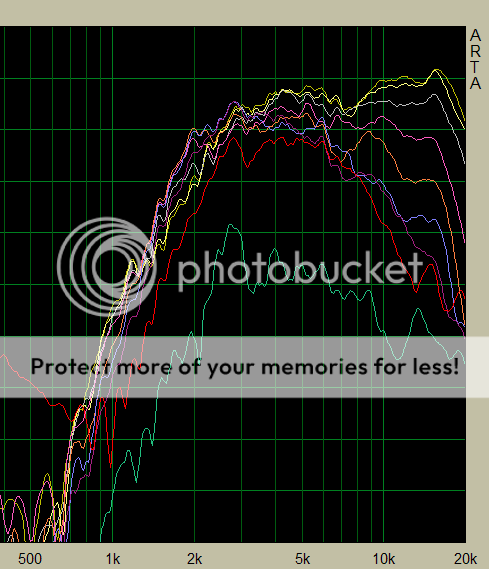
It's pretty bad and the response is all over the place.
When walking around the speakers with the tweeters playing pink noise I hear null from the sides. But it's different. The null is abrupt as shown in the last line. I'm not sure whether the null is due to dipole cancellation or simply the directivity of the tweeters.
I hope one day to replicate mige0's dipole tweeter setup and see.
I also took some measurement on back-to-back tweeter setup which is a common approach for a typical orion-ish setup. I haven't done careful measurements before knowing that it would be bad anyway and is the achilles heel of such setup.

It's pretty bad and the response is all over the place.
When walking around the speakers with the tweeters playing pink noise I hear null from the sides. But it's different. The null is abrupt as shown in the last line. I'm not sure whether the null is due to dipole cancellation or simply the directivity of the tweeters.
I hope one day to replicate mige0's dipole tweeter setup and see.
Very interesting results, indeed.This is the measurement of baffle with no structural wing
Could you give us a picture of the back of the baffle too? Just to have a better idea how those 4 cm strips are placed.
I know that this is mainly semantics, but mige0's dipole tweeter is no tweeter dipole. If the distance of the two dipole sources is much longer than the wavelength, both sources get de-correlated. In fact it would not make a real difference whether they would be dipole or bipole. There will be directivity because of the waveguide, but hardly any dipole loss IMHO.I also took some measurement on back-to-back tweeter setup ...
I hope one day to replicate mige0's dipole tweeter setup and see.
If you want tweeters with real dipole characteristics, they have to get as small as ever possible.
Have you tried running that mid driver free-air on top or on side with tweeter below & measure that..? maybe you could just remove & mock it up with existing baffle ..?
Joe
Joe
Very interesting results, indeed.
Could you give us a picture of the back of the baffle too? Just to have a better idea how those 4 cm strips are placed.
I know that this is mainly semantics, but mige0's dipole tweeter is no tweeter dipole. If the distance of the two dipole sources is much longer than the wavelength, both sources get de-correlated. In fact it would not make a real difference whether they would be dipole or bipole. There will be directivity because of the waveguide, but hardly any dipole loss IMHO.
If you want tweeters with real dipole characteristics, they have to get as small as ever possible.
No worries. This is what they look like from the back, and there's nothing special about the wings. One potential problem is resonance. I tapped on them using small mallet and I thought I can hear them radiate sounds. Perhaps some bracing will be needed (a triangular stuff every 20cm or so).
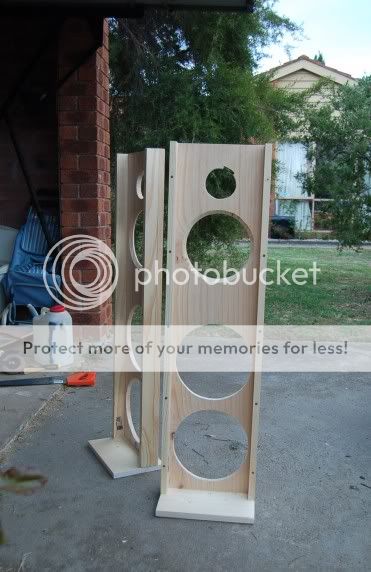
About the tweeter region, I'm not too fussed whether the ideal tweeters are operating as dipole or not, as long as the polar response is smooth. Something like Geddes' plots, only front to back. Am I thinking correctly?
Certainly not. 🙂No worries.
I was just curious, because your first picture did not show any evidence of wings whatsoever.
As I said - just semantics. Of course you are 'thinking correctly' if you go for best CD, regardless of dipole or not.About the tweeter region, I'm not too fussed whether the ideal tweeters are operating as dipole or not, as long as the polar response is smooth. Something like Geddes' plots, only front to back. Am I thinking correctly?
Indeed I´m not sure whether the other aspects of dipoles would be compelling enough for me, if there would be no built-in CD.
Conclusion ...!
Dipole Active Crossover
Much of the functions are clearly explained at Linkwitzlab website. What is unique is the need to compensate early rolloff of the Seas L21RNXP. The midrange exhibit some coloration due metal cone breakup harmonics and this would be the same even if the more expensive W22EX is used. It is not always audible and only appears in certain recording material.
Seas L21RNXP is an excellent unit aside from the normal metal resonance, however they have been discontinued. Seas L22RNXP is the drop-in replacement. Forget exotic drivers such as the W22, I may as well build the Orion. Why use metal cones then? Well the audible transparency of those drivers is unmatched. They are pistonic until that breakup arrives.
Hivi K1 tweeters exhibited very low distortion and excellent dispersion when crossed at 2.2khz or above with LR4. The tweeters could easily be substituted with something else, as long as the units have excellent distortion and dispersion. With those criteria it's hard to beat the cost of K1 ($12). Better tweeters would have allowed me to cross lower and help reduce midrange breakup coloration, but not much. Ideally 8" metal cones like L21/22 or W22 should only be used below 800hz.
Dipole Active Crossover
An externally hosted image should be here but it was not working when we last tested it.
Much of the functions are clearly explained at Linkwitzlab website. What is unique is the need to compensate early rolloff of the Seas L21RNXP. The midrange exhibit some coloration due metal cone breakup harmonics and this would be the same even if the more expensive W22EX is used. It is not always audible and only appears in certain recording material.
Seas L21RNXP is an excellent unit aside from the normal metal resonance, however they have been discontinued. Seas L22RNXP is the drop-in replacement. Forget exotic drivers such as the W22, I may as well build the Orion. Why use metal cones then? Well the audible transparency of those drivers is unmatched. They are pistonic until that breakup arrives.
Hivi K1 tweeters exhibited very low distortion and excellent dispersion when crossed at 2.2khz or above with LR4. The tweeters could easily be substituted with something else, as long as the units have excellent distortion and dispersion. With those criteria it's hard to beat the cost of K1 ($12). Better tweeters would have allowed me to cross lower and help reduce midrange breakup coloration, but not much. Ideally 8" metal cones like L21/22 or W22 should only be used below 800hz.
Construction
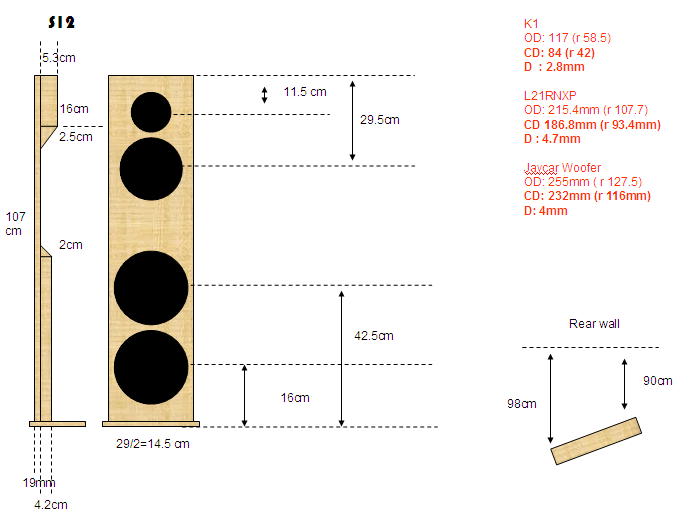
The side panels are not to increase acoustic path length as normally done by dipoles with "wings". They are for structural reasons, and generally the narrower the better. Although they are very narrow indeed (4.2cm) the midrange section should not be obstructed. I have observed audible midrange coloration if the side panels are simply extended through the midrange height, although I do not see it in the measurement. This could be a very high Q resonance which are hidden by diffraction effects in measurements.
The cavity for rear tweeter must be blocked, otherwise it forms a resonator. Stuffing the cavity using polyfill only helped marginally. It has to be angled to minimise diffraction issues with the midrange.
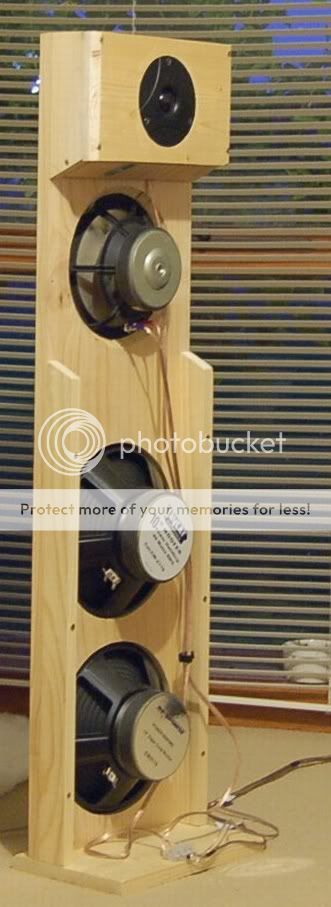

The side panels are not to increase acoustic path length as normally done by dipoles with "wings". They are for structural reasons, and generally the narrower the better. Although they are very narrow indeed (4.2cm) the midrange section should not be obstructed. I have observed audible midrange coloration if the side panels are simply extended through the midrange height, although I do not see it in the measurement. This could be a very high Q resonance which are hidden by diffraction effects in measurements.
The cavity for rear tweeter must be blocked, otherwise it forms a resonator. Stuffing the cavity using polyfill only helped marginally. It has to be angled to minimise diffraction issues with the midrange.

- Status
- Not open for further replies.
- Home
- Loudspeakers
- Multi-Way
- S12 OB - Returning to true OB